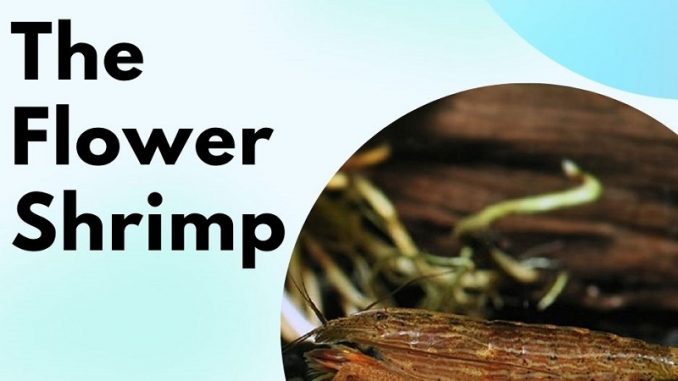
These shrimp are super fun to have in your tank. Flower shrimp have animated personalities, show off a little when they’re molting, and are genuinely peaceful additions to most community tanks. With their color-changing camouflage tricks, it’s like having a little light show in your aquarium.
In this article, we’ll explore the different facets of adopting Flower Shrimp into your community, including their behavior, appearance, tank requirements, and breeding habits.
TABLE OF CONTENTS
Flower Shrimp Facts & Overview
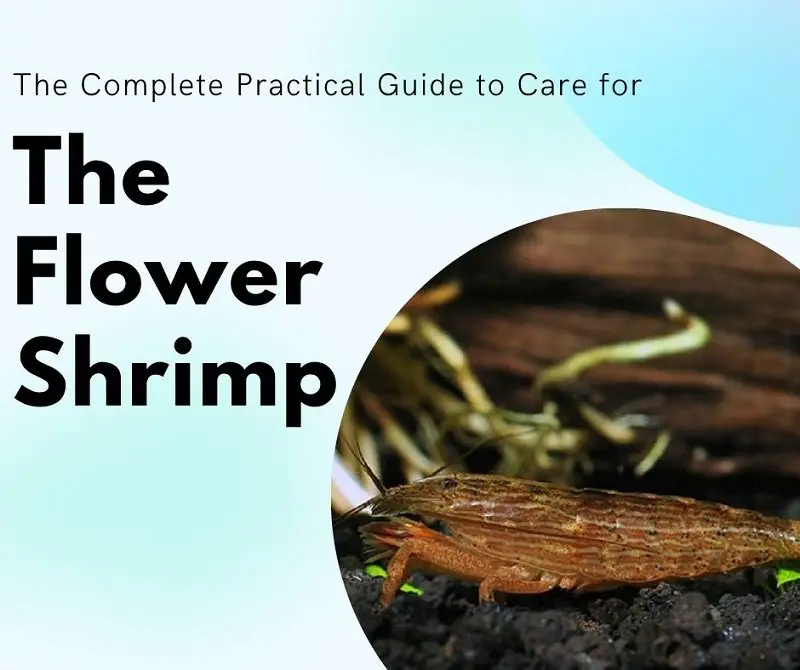
| Category | Rating |
| Care Level: | Easy |
| Temperament: | Peaceful |
| Color: | Brown, red, or tan |
| Lifespan: | 1-2 years |
| Size: | 3.5 inches |
| Diet: | Omnivore |
| Family: | Atyidae |
| Minimum Tank Size: | 20 gallons |
| Tank Set-Up: | Freshwater; pH 6.5-8; 68-85° F |
| Compatibility: | At-risk from large, aggressive fish |
The Flower shrimp, Atyopsis moluccensis, is a freshwater shrimp with origins in Southeast Asia. You’ll often hear Flower Shrimp referred to as Bamboo Shrimp, and they are popular inhabitants of aquarium communities.
You’ll see them in hobbyist’s tanks around the world, including Europe, the United States, and Asia. Because of their color variety, scientists previously thought there were multiple species, but the varieties are now known to all be part of Atyopsis moluccensis.
Other aliases for the Flower Shrimp include:
- Asian Filter Shrimp
- Fan Shrimp
- Filter Shrimp
- Maluku Shrimp
- Marble Shrimp
- Mountain Shrimp
- Rock Shrimp
- Singapore Flower Shrimp
- Timber Shrimp
- Wood Shrimp
Read Related Topic: The Essential Coral Banded Shrimp Care Guide
In their natural habitat, Flower Shrimp live in rivers and streams with fast currents, so they’ll like a stronger filter flow in your tank.
Because they’re so small and need to camouflage themselves for survival, they can change colors quickly, going from tan to brown to red. Some people also believe that they are like mood shrimp, changing color at their whim.
At about 3 ½ inches, the Flower shrimp is one of the more sizable freshwater shrimp, so you’ll need at least a 20-gallon tank. More room will give them plenty of space to explore and hide.
Make sure you provide them with lots of places to hide – plants and wood and caves are all appropriate for Flower shrimp. Even with hiding places, you should avoid adding them to a tank with larger and more aggressive fish that may want to eat them.
History
Atya moluccensis was first described in 1849; in 1925, Atya moluccensis was recognized as being different from other Atya species.
Appearance
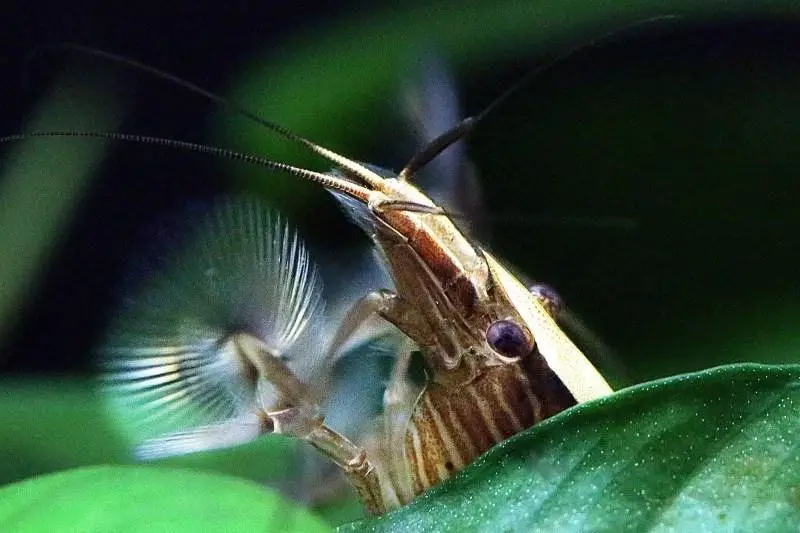
This is a good place to mention once again how colorful these shrimp are, and how quickly they can change colors. It only takes a few seconds for these shrimp to change color, so don’t despair if they seem to be missing from your tank. You’ll see them soon enough.
They also have a racer stripe down their backs; this stripe is easier to see in younger shrimp.
Flower shrimp have four pairs of fans with which they filter water and catch the food particles for nourishment.
Flower shrimp have two sets of antennae and two short eyestalks; at the base, they are thick. Flower shrimp can cover their eyes to shield themselves from threats.
A Flower shrimp’s carapace is thick and it has lines down the shell that look like wood grain. The shrimp’s back legs are thinner and shorter than the robust front legs.
After the carapace, Flower shrimp have 6 abdominal segments, and its tail is connected to the 6th segment. The tail has 4 flat segments and a telson, the short piece at the end that looks almost like a tail.
The Flower snail can narrow or widen its tail segments by sliding the segments slightly. Around the edge of the tail, segments are fine filaments. The Flower shrimp has the ability to snap its tail under its abdomen quickly, which allows the shrimp to thrust backward.
Female and Male Differentiation
- Females bodies are smaller
- First set of legs in larger in males
- Forelegs in older male shrimp have a strong claw
- Female gonopore (sexual opening) is found at the base of the third pair of legs
- Male gonopore is found at the fifth pair of legs
Typical Behavior
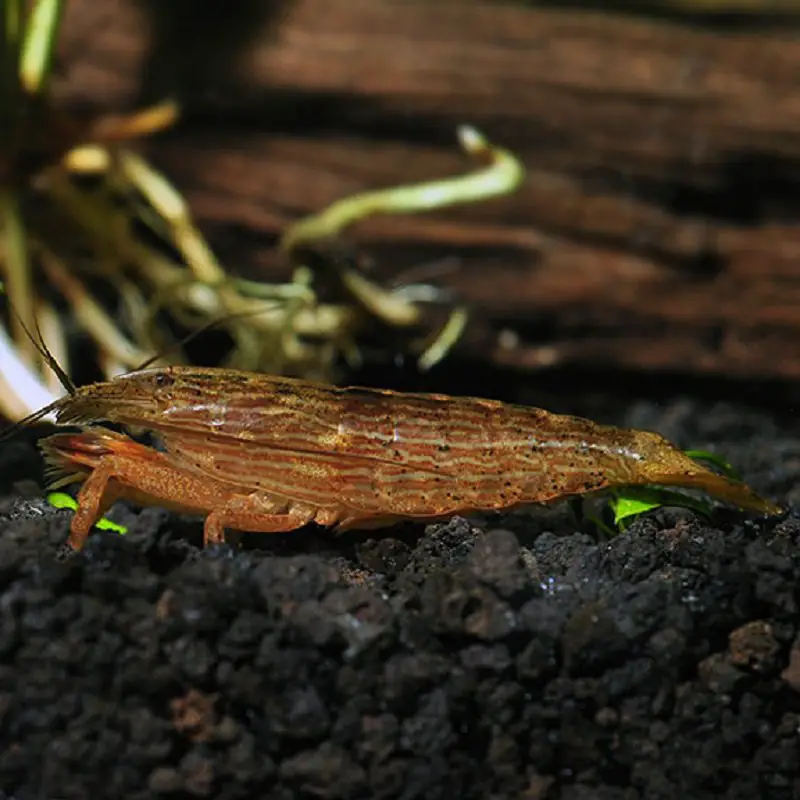
Flower shrimp are peaceful and get along well with snails, non-predatory fish, and dwarf shrimp.
The biggest time of danger is when you are adding the Flower shrimp to your tank; many shrimp do not survive the transition. You might notice that they do not move or each much at first, and they may seem shy.
They can also get very stressed out, so make sure the water conditions, including the current they like, are present in your tank. Optimal conditions will help calm them.
After they get acclimated to their environment, they are very peaceful and more playful. Be careful to have a lid on your tank or Flower shrimp may escape through the filter, just to see what’s out there.
Bamboo shrimp often can be very shy, especially in the beginning. At first, they do not eat or move much. However, after they have settled in, they become bolder and infinitely calm creatures day by day.
These shrimp have a life span of 1 to 2 years, assuming they have an environment in which they can thrive and are able to adapt to their new aquarium home.
Molting in Flower Shrimp
Flower shrimp molt every couple of months. A couple of days prior to molting, you’ll notice your Flower shrimp hiding more than usual.
After molting, the Flower shrimp will leave the old shell in the water, and other aquarium inhabitants eat it. One owner reports that the Flower shrimp’s exoskeleton is an exact clear replica of the Flower snail, antenna, and all.
Remember, a newly molted invertebrate is more vulnerable because its shell is soft, so make sure your tank has enough hiding places, and be careful cleaning the tank after a Flower shrimp has molted.
Generally, the Flower shrimp will stop eating a couple of days before the molting process is about to begin and also hunker down in a good hiding place to lay low until it’s molting time.
Pro tip: If you see Flower shrimp eating rock fragments from the substrate, try increasing how much food you are providing or the water current. Eating these fragments is not beneficial for Flower shrimp, and signals insufficient food.
Flower shrimp are solitary creatures, but thrive when they are in groups and maintain calm when they have others around them.
At night, you might be able to catch your Flower shrimp coming out of the woodwork.
In moving water, Flower shrimp spread their front legs, called chelae, and filter food particles through them. There are little bristle compartments that unfold like an umbrella, and food is caught in the fans and then they move them from the fans to the mouth. They hang onto whatever they can – rocks, driftwood, plants – so they are not swept away by the currents.
If your filter provides strong enough flow, the Flower shrimp will group together on a perch or rock and filter food.
Dead Flower Shrimp
It’s interesting to note that in the unfortunate event that a Flower shrimp dies, its tank mates will only eat the shell, not the actual shrimp. Amano shrimp and snails will eat molted shells, too, and likely enjoy the calcium they get from both a molted shell and the shell of a dead shrimp.
Other Flower shrimp will not cannibalize the dead shrimp.
Diet
Flower Shrimp will eat algae, leftover food, and waste in the tank and from the filter, so they clean your tank while they are nourishing themselves. They use their fans to filter tiny food particles from the water current, and sometimes feast on the bottom of the tank.
You can supplement food sources in the tank with flake food or crush algae wafers and moisten with water, and then add it to the current. Other acceptable supplements include pond plankton, micro worms, and spirulina powder.
Pro tip: Shrimp pellets are inappropriate for Flower shrimp, who need smaller particles.
To optimize feeding conditions, Flower shrimp should be introduced into an established tank with a plant habitat so that they have access to algae and plant decay.
If it seems as if there is too much competition at feeding time, you could try using a syringe for targeted feeding, which allows the Flower shrimp to get their share without oversaturating the tank. Too much food in the tank can compromise water quality.
Pro tip: If you swirl around the water in the current, it releases particles so that the Flower shrimp can find them in the swirl and filter them.
Additionally, if you reposition a plant and stir the substrate, it causes little concentrations of food to be circulated in the water so that they can eat.
Habitat and Tank Conditions
Flower shrimp thrive in a tank that has been cycled and contains plenty of microorganisms. An absolute necessity for Flower shrimp is water currents; they need their natural habitat mimicked in the aquarium setting.
You’ll need to add a filter to create a moderate current; if that doesn’t provide enough movement, you can add a flow pump to the tank, placed so that the Flower shrimp is in the middle of the current. Sponge filters are a popular choice with Flower shrimp.
Tank Conditions
Habitat
Flower shrimp do best in a lush aquarium with plants, rocks, and driftwood. They need hiding spots and places to hang out and filter food. If you can arrange a perch by the current, they’ll be happy as …well, Flower shrimp.
The plant habitat is important because it provides them with refuge from predators and during molting. In addition, the habitat creates a biome that provides nourishment and minerals to the tank
Water Conditions
Flower shrimp require a high oxygen level in their water. Ideal temperature range recommendation is 75° to 77° degrees F (24° to 25° degrees C), with moderate to medium-hard water.
Keep the tank water clean, but remember that Flower shrimp are scavengers and need some waste and algae for food.
Pro tip: Flower shrimp are super sensitive to changes in water temperature, so when you are cleaning the tank and doing partial water changes, check the temperature of the new dechlorinated water to make sure it matches the existing water, so as not to harm the shrimp.
Danger of Copper
We’ve discussed the dangers of copper to our invertebrate friends in other articles. The warning is appropriate here, as well. If you’re using plant fertilizer in your aquarium (and with a plant-rich environment to please your shrimp, you’re likely to), check the ingredients to make sure the fertilizer does not contain copper, which can be fatal to Flower shrimp.
Additionally, if you are treating fish for ich parasites, also check the label, as many brands contain copper. Look for products that are listed as “shrimp safe.”
Lack of Motion
Check the water levels and conditions if your Flower shrimp seems to be listless or hiding more than usual. While it’s true that a couple of days before molting, the Flower shrimp stops eating and hides. But if they are not molting, a lack of activity and appetite could be a sign that something is not right with the shrimp.
What Size Aquarium Do They Need?
Flower shrimp are filter feeders, so they’re getting food from the water column. Therefore, you need enough water volume to provide them with enough food. We recommend at least a 20-gallon tank, and a 20-gallon long tank might be ideal for keeping the food moving for the shrimp’s feeding habits.
Note: Flower shrimp need space, so a Nano tank is not appropriate for this species.
Tank Mates
As we mentioned before, flower shrimp experience less stress and a more peaceful existence when they are housed with a small group of 3 or 4. They also do well with snails and other freshwater shrimp, as well as smaller, non-aggressive shrimp.
Good Tank Mates
Catfish:
Snails:
- Assassin snail
- Gold Inca snail
- Japanese Trapdoor snail
- Ivory snail
- Malaysian Trumpet snail
- Mystery snail
- Nerite snail
- Rabbit snail
- Ramshorn snail
Shrimp:
Poor Tank Mates
Breeding
Although caring for Flower shrimp is easy, breeding them is the opposite. We’ve seen success with Flower shrimp hatching larvae, but without the salty, brackish water in their natural habitat, they don’t have a high survival rate.
After the eggs hatch into larvae, they proceed through a number of developmental stages before becoming shrimplets. In the wild, the current carries the larvae downstream to lagoons, which have a mixture of freshwater from the river and salt water from the ocean. It is in this brackish water that the shrimp larvae develop, after which they swim back upstream to their freshwater home.
The inability to mimic this lagoon water and a long trip, the Flower shrimp born in captivity have a decreased chance of survival to adulthood. Complicating matters is that the adult Flower shrimp (not to mention the other inhabitants of your aquarium) cannot handle salt in their water.
Hence, all the Flower shrimp sold are wild-caught.
Here’s the breeding process, as a matter of information; however, we don’t recommend that you try breeding at home.
When a female Flower shrimp is about 1.5 inches (4 cm), she is able to carry eggs, a state called berried. When she wants to breed, she will release hormones into the water, altering the male.
The male then deposits his sperm onto the female, who moves up to 2,000 orange eggs underneath her tail. These eggs, which remain under her abdomen for 30-40 days, turn brown during development.
When the eggs hatch, the larvae are less than 1 mm (about .04 inches!) The larvae are only to survive for about 2 days in freshwater, so if they are not in the wild, they must be transferred to a separate tank with brackish water until they are fully developed about 90 days. If you’re familiar with the breeding process and challenges of the Amano shrimp, this probably sounds familiar.
Caution: Never move the babies directly from brackish water to saltwater; a gradual decrease in salinity is vital.
Are Flower Shrimp a Great Addition to Your Aquarium?
Flower shrimp could very well prove to be the life of your aquarium. Changing color at will like an LED bulb, dancing around to catch food particles, shedding shells… Flower shrimp will keep you entertained day and night.
In addition to livening up your aquarium community, Flower shrimp help keep your tank sparkling clean.
The only possible drawbacks are that these shrimp don’t adjust well to new tank settings and may die during the transition time, and they won’t be a good fit for tanks with larger, more aggressive fish like cichlids.
These concerns aside, Flower shrimp is a great candidate for your aquarium community!
Do you have any questions or comments about the Flower shrimp? Leave your comments or questions in the section below. We’d love to be in touch.

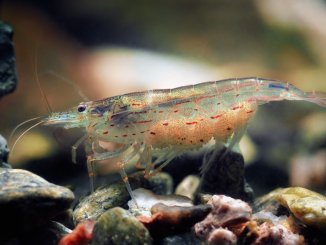
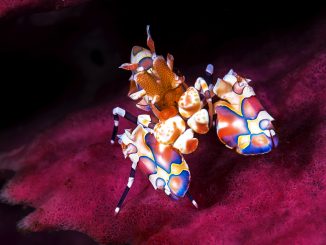
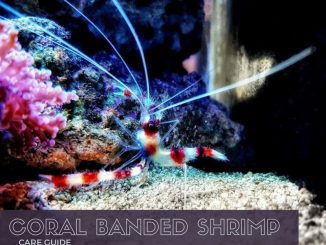
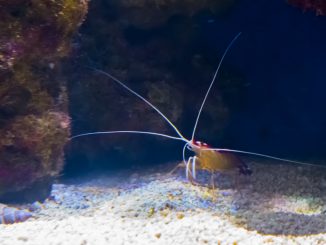
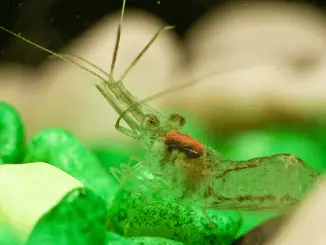
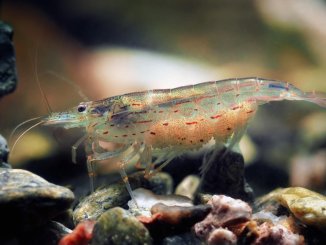
Be the first to comment